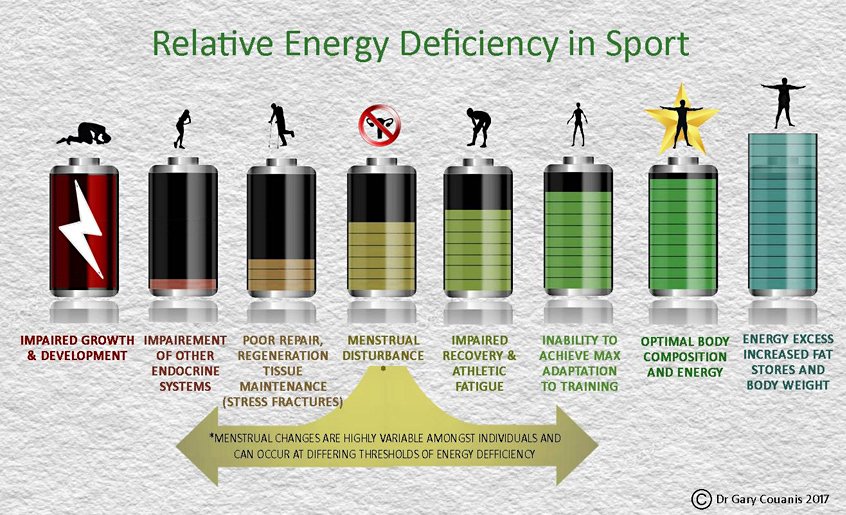In the world of running, athletes face numerous challenges in pursuit of peak performance and personal bests. However, a condition known as Relative Energy Deficiency in Sport (RED-S) can hinder their progress and overall well-being. This article aims to shed light on RED-S, its impact on runners, strategies for prevention and treatment, and the collective responsibility of athletes, coaches, and the sporting community in addressing this issue.
What is RED-S?
RED-S is a multi-system disorder that occurs when there is an inadequate energy intake to meet the energy requirements of the body, leading to various physiological and psychological consequences. Formerly known as the Female Athlete Triad, RED-S encompasses a broader range of symptoms and affects both male and female athletes across all sports, including runners.

Research evidence: A study published in the British Journal of Sports Medicine found that RED-S affects up to 60% of female athletes and 15% of male athletes. Another study in the Journal of Clinical Endocrinology and Metabolism demonstrated that endurance athletes, such as runners, are particularly susceptible to RED-S due to the high energy demands of their training.
Who suffers from RED-S?
RED-S can affect athletes of all ages and performance levels. It can occur in recreational runners, competitive amateurs, and elite professionals. While it is more prevalent in endurance-based sports like running, it can also impact athletes in other disciplines.
RED-S is often characterized by hormonal disruptions, including irregular or absent menstrual cycles in females and low testosterone levels in males. In addition, runners with RED-S may experience decreased bone density, impaired immune function, cardiovascular issues, gastrointestinal problems, and psychological disturbances like depression and anxiety.
Research evidence: A study published in Sports Medicine highlighted that RED-S can significantly impact athletic performance, leading to decreased endurance, slower recovery, increased injury risk, and compromised cognitive function. The same study emphasized that early detection and intervention are crucial to preventing long-term health consequences.

How to address RED-S?
Addressing RED-S requires a comprehensive approach that encompasses nutrition, training, and psychological support. Here are some strategies for prevention and treatment:
a) Nutrition: Athletes should work with qualified sports dietitians to ensure adequate energy intake to meet the demands of training and recovery. This involves consuming a well-balanced diet rich in macronutrients, vitamins, and minerals. Energy availability should be carefully monitored to avoid prolonged periods of energy deficiency.
Research evidence: A study in the International Journal of Sport Nutrition and Exercise Metabolism showed that increasing energy availability by 30-45 kcal/kg/day helped restore menstrual function and bone mineral density in female athletes with RED-S.
b) Training: Coaches and athletes need to prioritize periodization and recovery within training programs. Periodization involves planning training phases strategically to optimize adaptation while minimizing the risk of overtraining. Adequate rest and recovery periods should be included to allow the body to repair and adapt.
Research evidence: A systematic review in the Journal of Science and Medicine in Sport demonstrated that implementing a periodized training program reduced the incidence of RED-S symptoms in female endurance athletes.
c) Psychological Support: Athletes should have access to mental health resources and professionals who can help manage the psychological aspects of RED-S. Addressing body image concerns, promoting a healthy relationship with food, and providing coping strategies for stress and pressure are essential components of psychological support.
Research evidence: A study published in the International Journal of Sports Physiology and Performance emphasized the importance of psychological intervention in RED-S management, as it positively impacts athlete well-being and adherence to treatment plans.

Whose Responsibility?
Addressing RED-S is a collective responsibility that involves athletes, coaches, medical professionals, and the sporting community as a whole.
Athletes must take ownership of their well-being and prioritize their health over performance. They should be proactive in seeking appropriate medical advice, adhering to treatment plans, and communicating with their support team.
Coaches play a vital role in fostering a healthy training environment. They should receive education on RED-S and be knowledgeable about the warning signs, risk factors, and strategies for prevention. Coaches should emphasize open communication, provide adequate recovery periods, and promote a balanced approach to training and competition.
The sporting community, including governing bodies, should prioritize athlete welfare, provide education and resources on RED-S, and establish guidelines for its prevention and management. Collaboration among medical professionals, sports scientists, and coaches is essential to ensure a comprehensive approach to addressing RED-S.
RED-S poses significant risks to the health and performance of runners. By understanding the condition, implementing preventive measures, and fostering a supportive environment, we can mitigate the impact of RED-S in the running community. Athletes, coaches, and the sporting community all share the responsibility of addressing RED-S, ensuring the well-being of runners and supporting their pursuit of excellence on and off the track.
Thanks For Reading
James @physiorun
